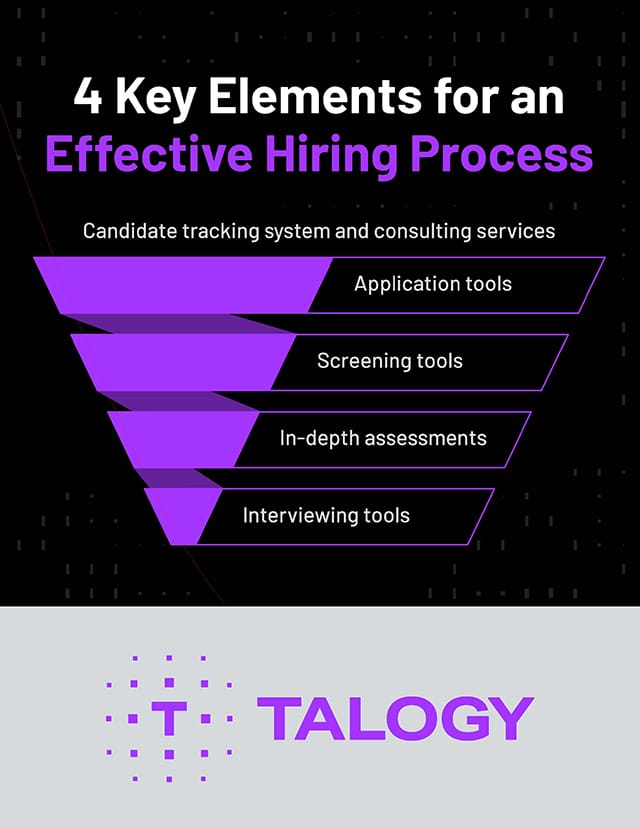Written by Hannah Siwik and Coleen Thomas
High-volume recruitment, also known as bulk or mass hiring, is the process of hiring a large number of employees within a condensed period of time. This can often be a challenge for organisations due to factors such as seasonal spikes, rapid organisational growth, and high turnover rates. High-volume recruitment is especially common in manufacturing, retail, and customer service industries.
How to structure a high-volume recruitment strategy
For HR professionals, managing a strategy for high-volume recruiting requires a balance of efficiency and innovation while simultaneously creating a positive candidate experience. To do this, we recommend focusing on three main initiatives: candidate sourcing, candidate screening, and a performance audit of the process itself.
Candidate sourcing in high-volume recruiting
One of the earliest and most critical steps of high-volume recruiting is candidate sourcing, which involves identifying and engaging with individuals who may or may not be actively looking for a job. This is achievable by focusing on strategic recruiting and analysing sourcing channels.
While traditional job boards like Indeed and LinkedIn still generate a significant number of applicants, expanding sourcing efforts to other platforms can connect organisations with a wider range of candidates. Some candidate sourcing resources to consider for high-volume recruitment include:
- Social media platforms like Instagram, YouTube, and even TikTok bring job descriptions directly to users while they are scrolling on their mobile phones. These platforms also offer creative ways to showcase a company’s culture, which can help attract talent in a more engaging and authentic way.
- More traditional sourcing strategies such as radio, television, and billboard advertisements can still provide returns, particularly in local or niche markets. Depending on the demographics and skills you are looking to attract, these tried-and-tested outreach methods may pay dividends when it comes to meeting the goals of your high-volume recruitment strategies.
- Participating in industry-specific events such as job fairs or career expos gets you in front of potentially hundreds of candidates at a single event. Additionally, these events demonstrate your company’s investment in connecting with and supporting targeted candidate pools such as early career professionals.
- Employee referral programmes can also be a great option as they allow employers to tap into their existing workforce to help find great talent.
Regardless of where a company advertises, they should always make sure there is a way for applicants to indicate where they heard about the job. This is essential information that can be used when analysing the effectiveness of a company’s sourcing efforts.
Candidate screening in high-volume recruiting
After candidate sourcing, you’ll need to review incoming applications and make sure candidates are able to do the job. When it comes to candidate screening in high-volume recruiting, it is important to ensure an efficient and consistent experience for all candidates throughout the application process.
To do so, and to help preserve HR resources, many organisations use an applicant tracking system (ATS) to collect general candidate information in a user-friendly format quickly and consistently. Recruiters can use pre-screening eligibility questions to filter out those who do not meet the minimum requirements of the job. Some common pre-screening eligibility questions will ask a candidate about:
- Level of education
- Related previous experience
- Legal requirements related to the job
- Willingness to work weekends, overtime, or rotating shifts
- Acceptance of certain physical job requirements such as being able to lift heavy objects
Once you’ve ensured that a candidate possesses and agrees to the basic requirements of the job, organisations can then move on to assessing candidates on a deeper level to see if they have the knowledge, skills, and abilities essential to the role for which they are applying. At this point, organisations should consider implementing an assessment followed by a structured interview to measure these factors.
Don’t forget to clearly communicate with candidates before and during each step of the application process. Give them an estimate of how long each hiring hurdle will take and when they can expect to hear back from you. Ideally, you will have an established resource that candidates can reach out to – such as an FAQ page or general inbox – in the case of questions or technical difficulties. Finally, be sure to follow up with every candidate and let them know whether or not they got the job. It may be helpful to also include details such as when they are eligible to reapply for other open job opportunities.
Performance audit of high-volume recruiting
As with any process, it’s worth spending some time to assess its effectiveness afterward. In high-volume recruiting, it is important to identify what was a good investment of time and budget, as well as areas that could improve the efficiency of the process and overall candidate experience. Important details to focus on when looking at the overall hiring process include certain Key Performance Indicators (KPIs).
Top KPIs for high-volume recruitment
There are several KPIs that are important for an organisation to focus on, but two critical metrics to measure during your performance audit of high-volume recruitment strategies are:
- Time-to-fill: The time it takes to fill a position can provide meaningful insight as it can shed light on inefficiencies within your current hiring process. For example, perhaps there is a background check vendor that is taking too long to provide results, or candidates are self-selecting out of the hiring process because there are not enough interview slots available for them to choose from. These are tangible takeaways that can be easily rectified once identified.
- Cost-per-hire: Organisations can look at the expenses associated with filling a position and then use that information to estimate future hiring costs, review their internal hiring costs over time, and compare costs with other similar organisations or industry benchmarks.
Remember those referral sources we mentioned earlier? Now is a great time to pull a report of where your candidates heard about your organisation and determine where your highest return is coming from in terms of successful hires. It’s worth revisiting this metric six months to a year after hiring dates as well. In doing so, this gives you a chance to see not only who has remained with the organisation, but also what the most common originating referral source was – at a minimum, ensuring that this successful sourcing method is used in future high-volume recruiting efforts.
Mastering high-volume recruitment in a competitive market
Despite the large size of applicants being processed with high-volume recruitment, you need to make sure that your candidates feel like they were truly seen and not lost in a proverbial pile of applications. Even if they do not end up joining your organisation, you want to ensure they walk away with a positive experience that won’t deter them from applying for other roles or becoming a customer of your company in the future.
With the influx of applications coming in during high-volume recruitment, it’s important to stick to an established selection process and prioritise quality hires over just filling empty roles. Hiring someone because you need ‘a body on the floor’ rarely works out and can lead to turnover and safety incidents that are very costly to the organisation. When high-volume recruiting is done correctly, you’ll make the most effective use of your resources and be left with qualified hires who move your organisation forward.
About the authors: Hannah Siwik, M.S., has expertise in designing, developing, and validating assessment systems. She has extensive experience leading large-scale job analysis projects and has developed a wide range of selection content including situational judgment tests, technical knowledge tests, and behavioural-based interview content. Hannah is also a member of the Society for Industrial and Organisational Psychology (SIOP).
Coleen Thomas, M.S., has extensive experience with supporting high-volume automotive manufacturing clients with their candidate screening and assessment needs. She has experience designing, developing, and validating assessment systems. Additionally, she has been involved with many job analyses and has advanced knowledge with building, delivering, and analysing job analysis surveys.



